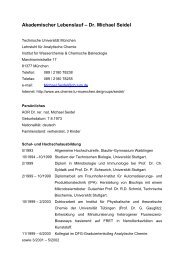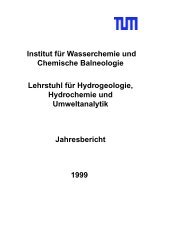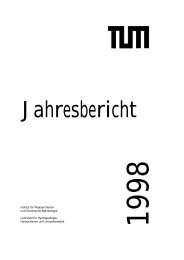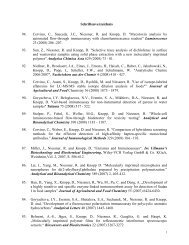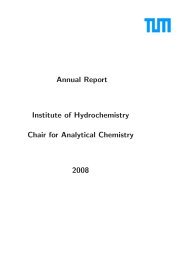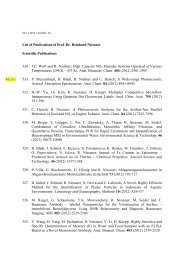IWC Annual Report 2003 - Institut für Wasserchemie und chemische ...
IWC Annual Report 2003 - Institut für Wasserchemie und chemische ...
IWC Annual Report 2003 - Institut für Wasserchemie und chemische ...
You also want an ePaper? Increase the reach of your titles
YUMPU automatically turns print PDFs into web optimized ePapers that Google loves.
with no further functional monomer. The second group described the preparation of<br />
MIP for 1-hydroxypyrene, based on divinylbenzene and styrene. Generally, imprinting<br />
PAHs is difficult, because non-covalent interactions like hydrogen bond, dipolar and/or<br />
ionic interactions cannot be formed. There only remain hydrophobic interaction, steric<br />
cavity, and π − π interaction which are one or two orders of magnitude weaker than<br />
the electrostatic forces.<br />
In the first part of the project, three different monomers and two cross-linkers were<br />
selected to synthesize six kinds of imprinted polymers. Further, both bulk polymerization<br />
and suspension polymerization was applied. The affinity and selectivity of<br />
the synthesized polymers to benzo(a)pyrene and nine other PAHs was investigated in<br />
detail with rebinding, solid-phase extraction and HPLC experiments.<br />
All the results indicate that the polarity of both monomer and cross-linker play in<br />
important role for affinity and retention behaviour. The affinities of the polymer to<br />
the analyte increased with the decreasing polarity of monomer and cross-linker. No<br />
significant difference in the affinity to benzo(a)pyrene was observed between MIPs and<br />
MIMs (molecularly imprinted microspheres). The preparation of nanoparticles and<br />
affinity layers on sensors is presently <strong>und</strong>er investigation.<br />
(J.-P. Lai)<br />
13



